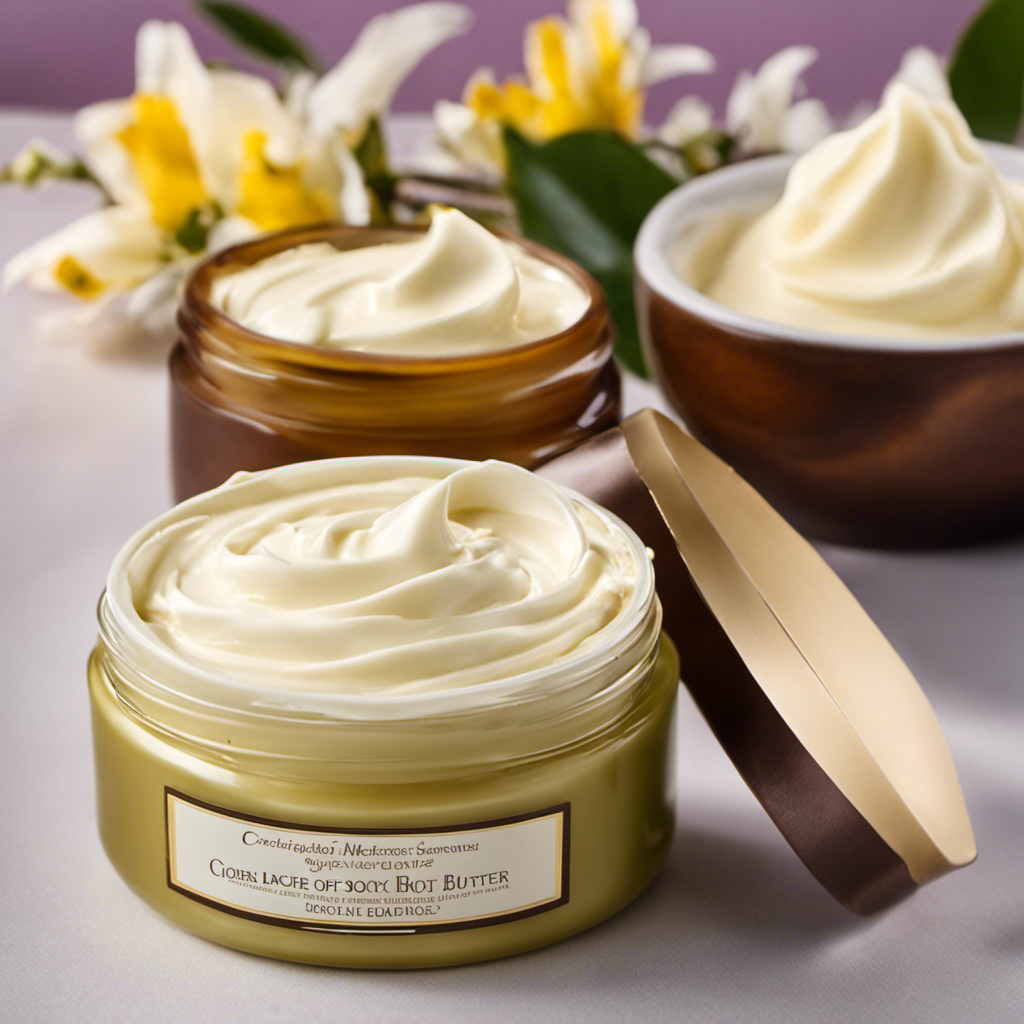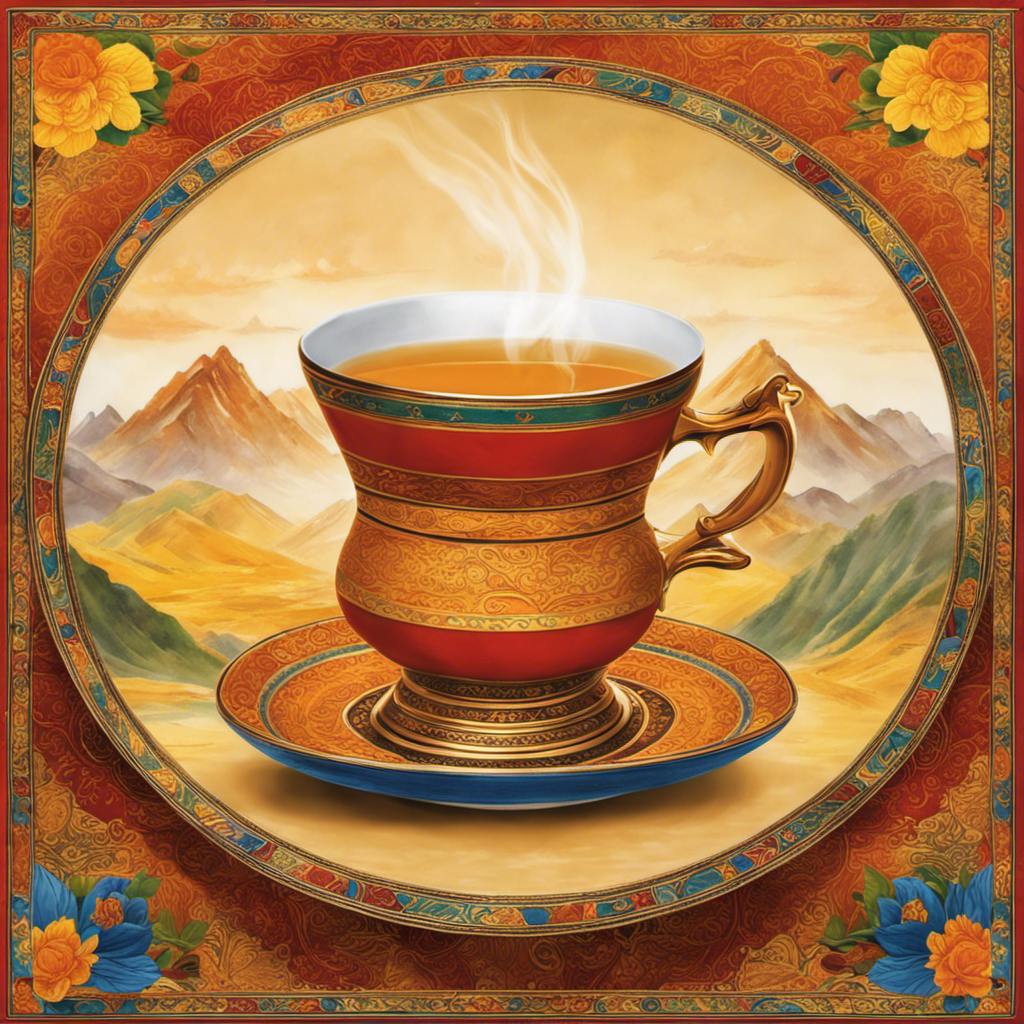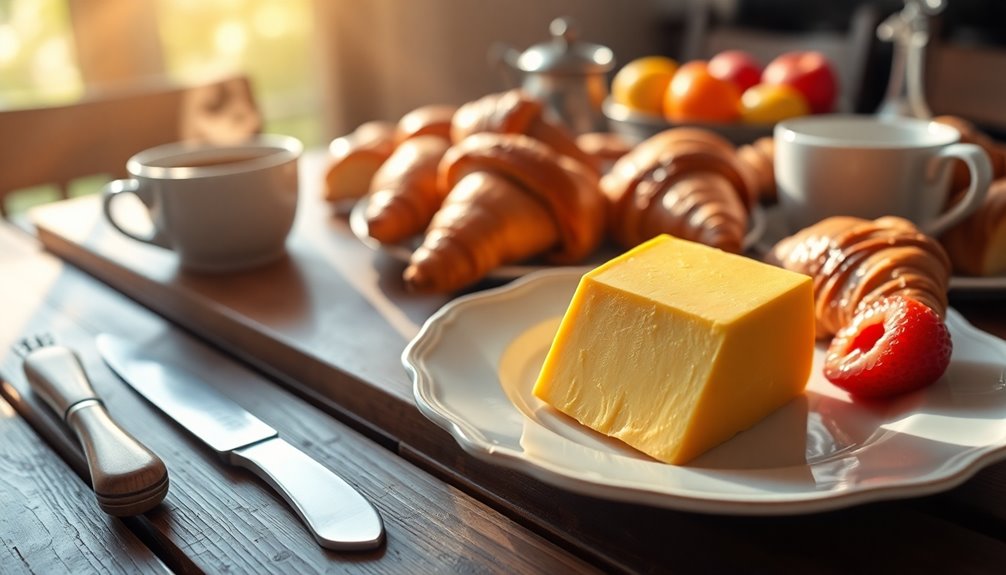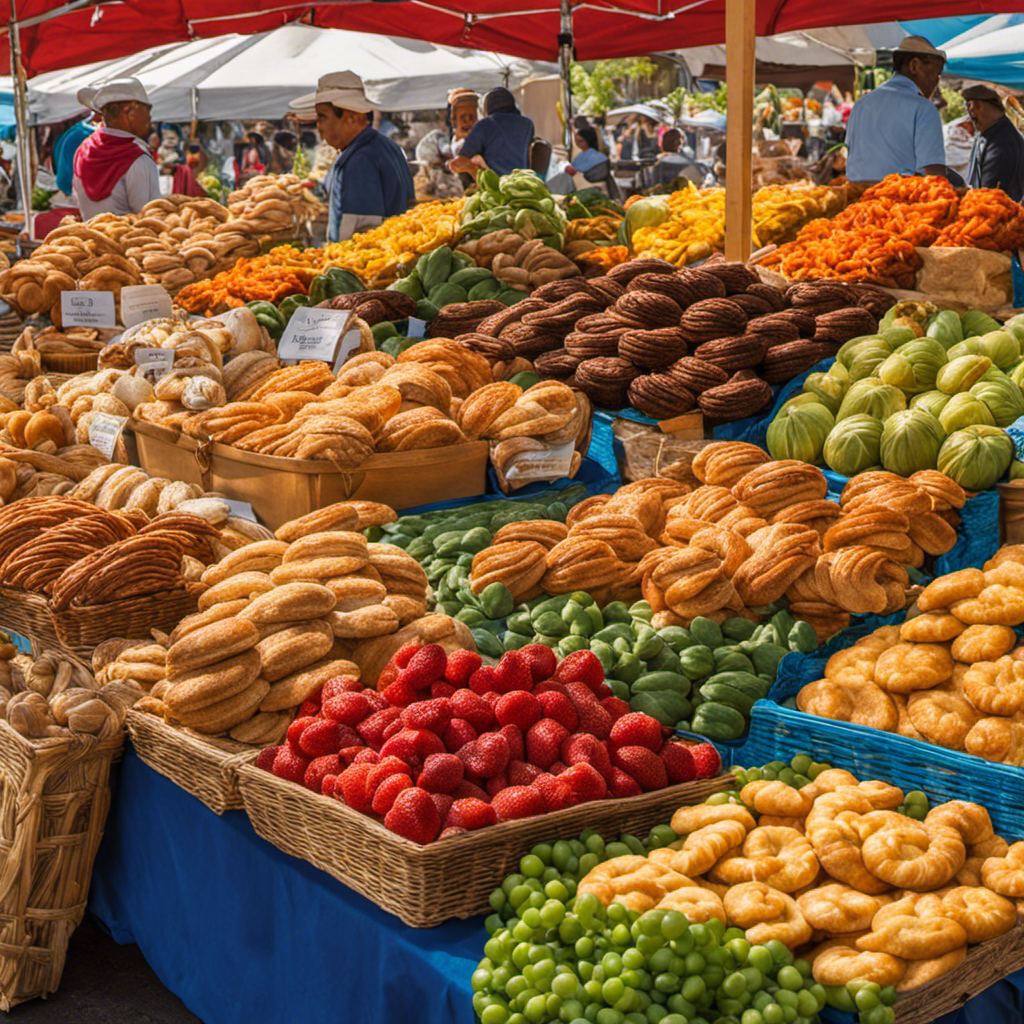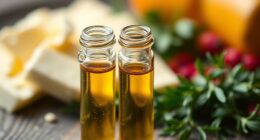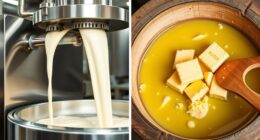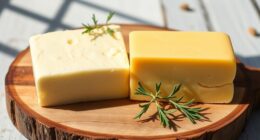As someone who is passionate about skincare, I have always been interested in the benefits of using body butter. Trust me, it makes a huge difference!
Body butter is a luxurious and nourishing skincare product that does wonders for your skin. It moisturizes and hydrates, soothes dryness, improves elasticity, and protects from environmental damage. Not to mention, it leaves your skin feeling soft and smooth.
Trust me, once you try body butter, you’ll never go back. Let’s dive deeper into the world of body butter and discover all its incredible uses.
Key Takeaways
- Body butter is used to moisturize and hydrate the skin, locking in moisture and preventing dryness and dehydration.
- It can soothe and heal dry or damaged skin, including cracked hands and cuticles, by nourishing and repairing the skin and reducing irritation and inflammation.
- Body butter is effective in repairing rough areas such as elbows, knees, and calloused feet by exfoliating dead skin cells and moisturizing to prevent dryness.
- It can also be used to soothe chapped lips by regularly applying lip balm, which repairs and nourishes the lips while forming a protective barrier against harsh environmental elements.
Moisturizing and Hydrating the Skin
Body butter is great for moisturizing and hydrating the skin. It has numerous hydrating benefits that can greatly improve your skincare routine. When applied to the skin, body butter forms a protective barrier that helps to lock in moisture, preventing dryness and dehydration. This is especially important for those with dry or sensitive skin, as it helps to replenish and restore moisture levels.
The rich and creamy texture of body butter allows it to deeply penetrate the skin, delivering essential nutrients and hydration. It is also formulated with nourishing ingredients such as shea butter, cocoa butter, and oils, which provide intense hydration and leave the skin feeling soft and supple. Adding body butter to your skincare routine can ensure that your skin stays moisturized and hydrated throughout the day.
Transitioning to the next section, body butter is also effective in soothing and healing dry or damaged skin.
Soothing and Healing Dry or Damaged Skin
As someone who’s struggled with dry and damaged skin, I understand the importance of finding effective solutions for specific problem areas.
In this discussion, I’ll be focusing on three key points: moisturizing cracked hands, repairing rough elbows, and soothing chapped lips.
I’ll provide professional, informative, and detailed advice on how to effectively address these concerns and restore your skin’s health and hydration.
Moisturizing Cracked Hands
Applying body butter can help with moisturizing cracked hands. When your hands are dry and cracked, it’s important to provide them with the nourishment they need to heal and prevent further damage. Body butter is a rich and creamy moisturizer that deeply penetrates the skin, providing intense hydration and relief.
Here are three ways body butter can benefit your cracked hands:
-
Healing cracked cuticles: The thick and luxurious texture of body butter creates a protective barrier over your cuticles, allowing them to heal and regenerate. Its emollient properties help to soften and smooth the rough skin around your nails, promoting healthier cuticles.
-
Preventing moisture loss: Body butter contains ingredients like shea butter and cocoa butter, which are known for their exceptional moisturizing properties. These ingredients create a barrier on the surface of your skin, locking in moisture and preventing dehydration.
-
Nourishing and soothing: Body butter is packed with vitamins and antioxidants that nourish and repair the skin. It soothes irritation and inflammation, providing instant relief to dry, cracked hands.
Repairing Rough Elbows
To repair rough elbows, it’s important to exfoliate and moisturize regularly.
Rough elbows can be caused by dryness, friction, or a buildup of dead skin cells.
To exfoliate, I recommend using a gentle scrub or a loofah to remove the dead skin cells and reveal smoother skin.
After exfoliating, it’s crucial to moisturize the elbows to keep them hydrated and prevent further dryness. Look for a moisturizer that contains ingredients like shea butter or coconut oil, as these can help nourish and soften the skin.
Additionally, if you have dry knees or calloused feet, you can follow the same exfoliating and moisturizing routine to repair and heal these areas as well.
Remember to be consistent with your skincare routine for the best results.
Soothing Chapped Lips
Don’t forget to regularly apply lip balm to soothe your chapped lips. As someone who has dealt with the discomfort of chapped lips, I can attest to the importance of keeping them moisturized.
Lip balm contains healing properties that work to repair and nourish your lips, preventing further dryness and discomfort. When you apply lip balm, imagine the soothing sensation as it glides across your lips, instantly relieving the dryness.
Visualize the balm forming a protective barrier, shielding your lips from harsh environmental elements. Envision the healing properties of ingredients like beeswax and shea butter, working deep within the layers of your skin to restore moisture and softness.
Improving Skin Elasticity and Firmness
Using body butter regularly can help enhance the elasticity and firmness of your skin. Body butter is a rich and creamy moisturizer that contains nourishing ingredients such as shea butter, cocoa butter, and essential oils. These ingredients work together to deeply hydrate the skin, promoting collagen production and improving skin elasticity.
As a result, body butter can help reduce the appearance of wrinkles and fine lines, giving your skin a more youthful and firm look. By massaging body butter onto your skin daily, you can enjoy its benefits and achieve smoother and more supple skin.
In addition to improving skin elasticity, body butter also acts as a protective barrier, shielding the skin from environmental factors such as harsh weather conditions and pollution. This helps to maintain the health and vitality of your skin.
Protecting the Skin From Environmental Factors
When it comes to skincare, it’s important to protect our skin from environmental factors that can cause damage. Two key points to consider are shielding against pollution and defending from harsh weather.
Pollution can contribute to premature aging and skin damage, so it’s crucial to use products that create a barrier against pollutants.
Additionally, harsh weather conditions like extreme cold or dryness can strip our skin of moisture and lead to dryness and irritation.
Shielding Against Pollution
Body butter can help protect your skin from pollution by forming a barrier on the surface. Pollution prevention is an essential aspect of skincare routines, as environmental factors can lead to premature aging and skin damage.
Here are three ways body butter shields against pollution:
-
Creates a Protective Layer: Body butter creates a physical barrier on the skin, preventing pollutants from penetrating and clogging pores.
-
Locks in Moisture: By deeply moisturizing the skin, body butter strengthens the skin’s natural barrier, making it more resilient against pollution.
-
Nourishes and Repairs: Body butter contains rich ingredients like shea butter and cocoa butter, which provide antioxidants and fatty acids that repair and replenish damaged skin.
Incorporating body butter into your skincare routine can help combat the harmful effects of pollution, leaving you with healthier, more radiant skin.
Defending From Harsh Weather
One way to defend your skin from harsh weather is by applying body butter. Body butter creates a protective barrier that shields against extreme conditions. Harsh weather, such as extreme temperatures, can wreak havoc on our skin. It can cause it to become dry, cracked, and irritated. However, body butter acts as a shield, preventing moisture loss and keeping the skin hydrated and supple.
The thick, creamy texture of body butter allows it to deeply penetrate the skin. This provides long-lasting hydration and nourishment. Body butter contains rich ingredients like shea butter, cocoa butter, and oils. These ingredients are known for their moisturizing properties.
Nourishing and Softening Rough or Rough Areas
Using body butter can help in nourishing and softening rough or rough areas of the skin. It is a nourishing treatment that provides relief to dry, flaky skin. When applied, body butter creates a protective barrier that locks in moisture and prevents further dryness.
Here are three ways body butter works its magic:
-
Deep hydration: The rich and creamy texture of body butter allows it to deeply penetrate the skin, providing intense hydration to rough areas. It moisturizes and replenishes the skin’s natural oils, leaving it soft and supple.
-
Smoothing rough patches: Body butter contains emollients that smooth out rough patches by softening the skin’s surface. It helps to minimize the appearance of dry, rough areas, giving your skin a smoother and more even texture.
-
Long-lasting moisture: Unlike regular lotions, body butter provides long-lasting moisture and nourishment. It forms a protective layer on the skin, preventing moisture loss and keeping your skin hydrated throughout the day.
With its nourishing properties and ability to provide rough skin relief, body butter is an essential skincare product for anyone looking to achieve softer, smoother skin.
Enhancing the Overall Appearance and Texture of the Skin
By incorporating body butter into my skincare routine, I can enhance the overall appearance and texture of my skin. Body butter is a rich and nourishing moisturizer that helps to lock in moisture, leaving my skin feeling soft and supple.
It contains ingredients like shea butter, cocoa butter, and oils that deeply hydrate and nourish the skin. Not only does body butter provide intense hydration, but it also helps to enhance skin radiance and promote a youthful complexion.
The luxurious texture of body butter allows it to glide onto the skin effortlessly, leaving behind a velvety smooth finish. With regular use, I have noticed that my skin looks more radiant, healthier, and feels incredibly smooth.
Incorporating body butter into my skincare routine has truly transformed the overall appearance and texture of my skin.
Frequently Asked Questions
Can Body Butter Be Used on the Face?
No, body butter should not be used on the face. It can clog pores and potentially cause acne. Additionally, body butter is not suitable as a makeup primer as it may not provide the necessary base for long-lasting makeup.
How Often Should Body Butter Be Applied?
I apply body butter daily to keep my skin moisturized and smooth. It lasts for a long time, and I find that applying it right after a shower locks in the moisture effectively.
Can Body Butter Help With Skin Conditions Like Eczema or Psoriasis?
Yes, body butter can help with dry skin. It is safe for sensitive skin as long as you choose a fragrance-free and hypoallergenic option. Body butter provides intense hydration and nourishment for the skin.
Is Body Butter Suitable for All Skin Types?
Body butter is suitable for all skin types. It provides numerous benefits, such as deep hydration and nourishment. The key lies in its ingredients, like shea butter and essential oils, which work wonders for the skin.
Can Body Butter Be Used as a Substitute for Sunscreen?
No, body butter should not be used as a substitute for sunscreen. While it can be a moisturizer and beneficial for dry skin, it does not provide the necessary protection against harmful UV rays.
Conclusion
In conclusion, body butter is truly a miracle product that can transform your skin in ways you never thought possible. Its moisturizing and hydrating properties are unparalleled, leaving your skin feeling like a baby’s bottom.
It soothes and heals dry or damaged skin like a magic potion, making you wonder if it has supernatural powers. Not only does it improve skin elasticity and firmness, but it also acts as a shield against environmental factors, like a superhero protecting your skin.
And let’s not forget how it nourishes and softens rough areas, giving you skin so smooth, you’ll feel like you’re gliding on air. With body butter, the overall appearance and texture of your skin will be so flawless, it’s like a work of art.
So go ahead and indulge in this luxurious treat for your skin, because you deserve nothing but the best.
